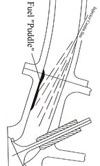Electronics v Chemistry
 Do we need electronic engine management systems? Really need them?
Do we need electronic engine management systems? Really need them?
Because controlling fuelling, ignition, even valve timing, duration and lift achievable through electronic control units doesn’t necessarily mean that is the best or even the right solution. That is a deliberately controversial statement but it is worth considering what lies behind it and what the alternatives and options are.
At its simplest, an engine needs oxygen and the right amount of fuel in order to breathe. Attach a supercharger or turbocharger, and you cram more oxygen in allowing more fuel to be oxidised. Which is why a 1.5 litre serially supercharged V16 had about the same outputs as a 4.5 litre naturally aspirated engine.
In ignition terms, a spark plug ionises the gas mixture around it, starting a complex combustion process that relies on long chain molecules breaking down.
The chemistry relies on hydroxyl radicals: in a common rail diesel the break down relies
on sono-chemistry where cavitation or vacuum voids are produced by the very droplet speeds and the design of the injector nozzles. In a gasoline engine, that breakdown – the pre-combustion chemistry – relies on exposing as many fuel molecules to oxygen as possible and to the ionisation process. This is why a gasoline engine needs more and more advance as the revs rise because the time available for pre-combustion chemistry reduces.
OK, that was a child’s guide to engines – what does it have to do with control systems? So the modern control system is provided with a memory that can be programmed with differing parameters for different performance requirements which is then able to control the variable elements of an engine in order to meet the performance demands. Is there are an alternative?
If you look at the chemistry and the time that the chemistry requires, things become clearer. Probably the most important thing is to deliver a fuel/air mixture with enough light fractions broken off the hydro-carbon molecules to give a sustained oxidisation. To do that takes a specific amount of time that is absolutely independent of engine speed. If the time isn’t long enough, the unburnt hydrocarbons will pollute the exhaust. You can optimise combustion by completing as much of the pre-combustion chemistry as possible and really one way is to time injection so that the fuel droplets can oxidise before reaching the combustion chamber.
An alternative – which is where possible redundancy in ECU’s comes in – is to control the chemistry. In some engines that can be done by recirculating exhaust gases which are rich in hydroxyls, the key bit of chemistry. An alternative is to increase the hydroxyl level of the intake air.
Either way, engine control can be achieved without mapping and, in the latter case especially, with a fixed ignition timing. In other words, listen to what the engine says. Increase the load and combustion chemistry changes. Reduce it, and it changes again.
So if you measure combustion efficiency by sensing increases of decreases in unburnt hydrocarbons, you can achieve more by clever chemistry than you can by complex mapping.
Or that at least is the theory that may become more and more relevant as fuel efficiency is pursued.
Written by David MacDonald.